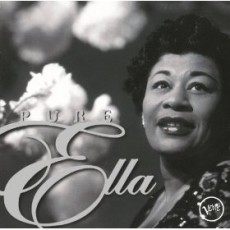
Daily Dose Of Jazz…
Ella Jane Fitzgerald was born on April 25, 1917 in Newport News, Virginia, the child of common law parents who separated shortly after her birth. Her mother moved her to Yonkers, New York and as a child she wanted to be a dancer but loved listening to the jazz of Louis Armstrong, Bing Crosby and The Boswell Sisters.
However, losing her mother to a heart attack in 1932 and the subsequent trauma caused her grades to drop, skip school, become a bordello lookout, and become involved with a Mafia affiliated numbers runner. This trouble led to reform school, ultimate escape, homelessness, and apprehension and sent to the Colored Orphan Asylum in the Bronx.
Ella made her singing debut at age 17 on November 21, 1934 at the Apollo Theatre. Pulling in a weekly audience won her the opportunity to compete in the Amateur Nights where she won first prize. Her winning spirit led her to perform with the Tiny Bradshaw band at the Harlem Opera House in 1935, and then to meet Chick Webb who offered her an opportunity to test with the band at a Yale University dance. This led to a regular gig with Webb at the Savoy Ballroom and in 1938 her rendition of the nursery rhyme A-Tisket, A-Tasket that she co-wrote, brought her wide public acclaim. When Webb died in 1939, Ella became the bandleader renaming it Ella Fitzgerald and Her Famous Orchestra, and went on to record nearly 150 songs during this tenure.
Pursuing a solo career she left the band, signed with Decca Records, began working with Norman Granz’s Jazz At The Philharmonic, and saw the demise of swing and the big touring bands. With Granz as her manager creating Verve Records around her and the advent of bebop, Fitzgerald changed her style of singing evident in her work with Dizzy Gillespie. She included scat in her repertoire and her rendition of Flying Home became one of the most influential vocal jazz records. Other songs like Oh, Lady Be Good would enhance her reputation as an important jazz vocalist.
Over the course of a career spanning nearly 60 years she recorded her now famous songbooks, recorded for a host of labels, performed all over the world. Fitzgerald appeared on film in Pete Kelly’s Blues, St. Louis Blues, and Let No Man Write My Epitaph. On television her most famous commercial was with Memorex in which her singing of a note and the subsequent playback shatters a glass – “Is it live or is it Memorex?”
Ella Fitzgerald, the three-octave vocalist noted for her purity of tone, impeccable diction, phrasing, intonation and horn-like improvisation ability is considered one of the supreme interpreters of the Great American Songbook. She has been photographed by Annie Liebovitz, won 14 Grammy awards, received the National Medal of Art by President Ronald Reagan and the Presidential Medal Of Freedom from George H.W. Bush.
After a long battle with diabetes Ella Fitzgerald passed away on June 15, 1996 at the age of 79 in Beverly Hills, California. So important was her contribution to the genre that her career history and archival material are housed at the Archives Center at the Smithsonian’s National Museum of American History; her personal music arrangements are at The Library of Congress; her extensive cookbook collection was donated to the Schlesinger Library at Harvard University; and her published sheet music collection is at the Schoenberg Library at UCLA.
More Posts: vocal


